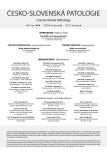Two autopsy cases in which previous surgery facilitated the positive identification of decomposed bodies
Authors:
Shogo Kasuda; Risa Kudo; Katsuya Yuui; Hiroko Imai; Masatoshi Nakata; Katsuhiko Hatake
Authors‘ workplace:
Department of Legal Medicine, Nara Medical University, Nara, Japan
Published in:
Soud Lék., 61, 2016, No. 4, p. 42-43
Category:
Original Article
Overview
The positive identification of decomposed corpses is often difficult. We describe two autopsy cases in which medical materials, which had been implanted during previous surgical treatments, facilitated positive identification. The discovery of decomposed corpses is increasingly common in Japan, due to the increasing number of lonely deaths. Implanted medical materials and devices may be a useful tool for personal identification in the near future.
Keywords:
personal identification – implanted medical devices – elderly people – lonely death
Sources
1. Benecke M. DNA typing in forensic medicine and in criminal investigations: a current survey. Naturwissenschaften 1997; 84(5): 181-188.
2. Holobinko A. Forensic human identification in the United States and Canada: a review of the law, admissible techniques, and the legal implications of their application in forensic cases. Forensic Sci Int 2012; 222(1-3): 394.e1-13.
3. Caplan RM. How fingerprints came into use for personal identification. J Am Acad Dermatol 1990; 23(1): 109-114.
4. Issacs TW, Margolius KA, Chester GH. Postmortem identification by means of a recovered intraocular lens. Am J Forensic Med Pathol 1997; 18(4): 404-405.
5. Kinoshita H, Motomura H, Kasuda S, et al. Positive identification facilitated by implanted metallic plate and screws. Soud Lek 2009; 54(2): 16.
Labels
Anatomical pathology Forensic medical examiner ToxicologyArticle was published in
Forensic Medicine

2016 Issue 4
Most read in this issue
- Post mortem investigation of alveolar air in forensic practice
- Two autopsy cases in which previous surgery facilitated the positive identification of decomposed bodies
